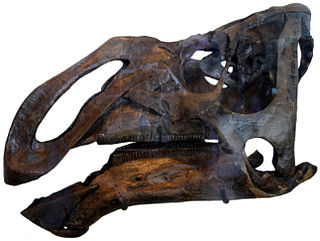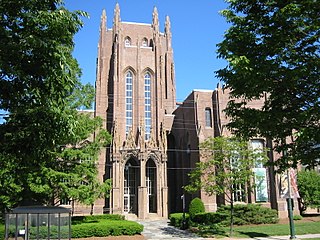External links
- "Home page" . Retrieved 27 October 2017.
- "Arctos Agent Page" . Retrieved 27 October 2017.
Spencer George Lucas | |
|---|---|
| Citizenship | American |
| Alma mater | University of New Mexico, Yale University [1] |
| Scientific career | |
| Fields | Paleontology |
| Institutions | New Mexico Museum of Natural History and Science [1] |
| Author abbrev. (zoology) | S. G. Lucas |
Spencer George Lucas is an American paleontologist and stratigrapher, and curator of paleontology at the New Mexico Museum of Natural History and Science. His main areas of study are late Paleozoic, Mesozoic and early Cenozoic vertebrate fossils, stratigraphy, and continental deposits, particularly in the American Southwest. His research has taken him on field trips to northern Mexico, Costa Rica, Nicaragua, Jamaica, Kazakhstan, and Georgia, and he conducted extensive field and museum research in China in the 1980s and 1990s. He has written more than 500 scientific contributions (about 25-percent are articles in peer-reviewed journals), three books, and has co-edited 14 books.
In 2007, some publications by Lucas and associates at the New Mexico Museum of Natural History and Science came under scrutiny after allegations that information was improperly taken from the unpublished and in-press work of graduate students not on his team. Formal complaints were made to the New Mexico Department of Cultural Affairs regarding publications on a new genus of aetosaur (a type of armored prehistoric reptile from the Triassic), and a reinterpretation of another aetosaur's armor. [2] In July 2008, the Ethics Committee of the Society of Vertebrate Paleontology concluded that the matter could not be resolved in favor of either side. [3]
In 2012, he co-authored a paper describing the world's smallest tetrapod footprints, found at Joggins, Nova Scotia. [4]
Lucas was a master-level chess player (New Mexico state champion in 1973 and 1974). [5] He gave up chess, for the most part, in the mid-1970s to focus on his academic career.[ citation needed ]

Kritosaurus is an incompletely known genus of hadrosaurid (duck-billed) dinosaur. It lived about 74.5-66 million years ago, in the Late Cretaceous of North America. The name means "separated lizard", but is often mistranslated as "noble lizard" in reference to the presumed "Roman nose".
Coelurus is a genus of coelurosaurian dinosaur from the Late Jurassic period. The name means "hollow tail", referring to its hollow tail vertebrae. Although its name is linked to one of the main divisions of theropods (Coelurosauria), it has historically been poorly understood, and sometimes confused with its better-known contemporary Ornitholestes. Like many dinosaurs studied in the early years of paleontology, it has had a confusing taxonomic history, with several species being named and later transferred to other genera or abandoned. Only one species is currently recognized as valid: the type species, C. fragilis, described by Othniel Charles Marsh in 1879. It is known from one partial skeleton found in the Morrison Formation of Wyoming, United States. It was a small bipedal carnivore with elongate legs.

Aetosaurs are heavily armored reptiles belonging to the extinct order Aetosauria. They were medium- to large-sized omnivorous or herbivorous pseudosuchians, part of the branch of archosaurs more closely related to crocodilians than to birds and other dinosaurs. All known aetosaurs are restricted to the Late Triassic, and in some strata from this time they are among the most abundant fossil vertebrates. They have small heads, upturned snouts, erect limbs, and a body ornamented with four rows of plate-like osteoderms. Aetosaur fossil remains are known from Europe, North and South America, parts of Africa, and India. Since their armoured plates are often preserved and are abundant in certain localities, aetosaurs serve as important Late Triassic tetrapod index fossils. Many aetosaurs had wide geographic ranges, but their stratigraphic ranges were relatively short. Therefore, the presence of particular aetosaurs can accurately date a site in which they are found.

Astrodon is a genus of large herbivorous sauropod dinosaur, measuring 20 m (66 ft) in length, 9 m (30 ft) in height and 20 metric tons in body mass. It lived in what is now the eastern United States during the Early Cretaceous period, and fossils have been found in the Arundel Formation, which has been dated through palynomorphs to the Albian about 112 to 110 million years ago.
Spinosuchus is an extinct genus of trilophosaurid allokotosaur from the Late Triassic of Texas, southern United States. It has been assigned to a variety of groups over its history, from coelophysid dinosaur to pseudosuchian to uncertain theropod dinosaur and to Proterosuchidae. This uncertainty is not unusual, given that it was only known from a poorly preserved, wall-mounted, partial vertebral column of an animal that lived in a time of diverse, poorly known reptile groups. However, newly collected material and recent phylogenetic studies of early archosauromorphs suggest that it represents an advanced trilophosaurid very closely related to Trilophosaurus.

The Kirtland Formation is a sedimentary geological formation.

Charles Whitney Gilmore was an American paleontologist who gained renown in the early 20th century for his work on vertebrate fossils during his career at the United States National Museum. Gilmore named many dinosaurs in North America and Mongolia, including the Cretaceous sauropod Alamosaurus, Alectrosaurus, Archaeornithomimus, Bactrosaurus, Brachyceratops, Chirostenotes, Mongolosaurus, Parrosaurus, Pinacosaurus, Styracosaurus ovatus and Thescelosaurus.

Walter Willis Granger was an American vertebrate paleontologist who participated in important fossil explorations in the United States, Egypt, China and Mongolia.
Lucasuchus is an extinct genus of aetosaur. Fossils have been found from the Bull Canyon Formation of the Dockum Group outcropping in the Revuelto Creek locality in Quay County, New Mexico. All specimens date back to the Norian stage of the Late Triassic. The genus was named in 1995 after the American paleontologist Spencer G. Lucas.

Martin G. Lockley is a Welsh palaeontologist. He was educated in the United Kingdom where he obtained degrees and post-doctoral experience in Geology in the 1970s. Since 1980 he has been a professor at the University of Colorado at Denver, (UCD) and is currently a Professor Emeritus. He is best known for work on fossil footprints and was former director of the Dinosaur Tracks Museum at UCD. He is an Associate Curator at the University of Colorado Museum of Natural History and Research Associate at the Denver Museum of Nature and Science. During his years at UCD he earned a BA in 2007 in Spanish with a minor in Religious Studies, became a member of the Scientific and Medical Network and taught and published on the evolution of consciousness.

Paratypothorax is an extinct genus of aetosaur, known from a single species, Paratypothorax andressorum. It was a broadly distributed member of the group found in Germany, North America, and possibly parts of Gondwana. The best specimens come from Germany, though for more than a century they were mistakenly considered phytosaur armor. Paratypothorax was a large and wide-bodied typothoracine aetosaur, as well as the namesake of the tribe Paratypothoracisini.

Stegomosuchus is an extinct genus of small protosuchian crocodylomorph. It is known from a single incomplete specimen discovered in the late 19th century in Lower Jurassic rocks of south-central Massachusetts, United States. It was originally thought to be a species of Stegomus, an aetosaur, but was eventually shown to be related to Protosuchus and thus closer to the ancestry of crocodilians. Stegomosuchus is also regarded as a candidate for the maker of at least some of the tracks named Batrachopus in the Connecticut River Valley.

The Ojo Alamo Formation is a geologic formation in New Mexico spanning the Mesozoic/Cenozoic boundary. Non-avian dinosaur fossils have controversially been identified in beds of this formation dating from after the Cretaceous–Paleogene extinction event, but these have been explained as either misidentification of the beds in question or as reworked fossils, fossils eroded from older beds and redeposited in the younger beds.
Redondasuchus is an extinct genus of aetosaur. It may be a junior synonym of Typothorax coccinarum, another aetosaur. Redondasuchus is a member of the clade Typothoracisinae within the subfamily Aetosaurinae, and lived during the middle Norian stage of the Late Triassic. Material belonging to the genus has been found from the Redonda Formation in east-central New Mexico. The type species, R. reseri, was named in 1991 after having been referred to as a species of Typothorax since 1985. A second species, R. rineharti, was described in 2006.

Edwin Harris "Ned" Colbert was a distinguished American vertebrate paleontologist and prolific researcher and author.

Paleontology in Oklahoma refers to paleontological research occurring within or conducted by people from the U.S. state of Oklahoma. Oklahoma has a rich fossil record spanning all three eras of the Phanerozoic Eon. Oklahoma is the best source of Pennsylvanian fossils in the United States due to having an exceptionally complete geologic record of the epoch. From the Cambrian to the Devonian, all of Oklahoma was covered by a sea that would come to be home to creatures like brachiopods, bryozoans, graptolites and trilobites. During the Carboniferous, an expanse of coastal deltaic swamps formed in areas of the state where early tetrapods would leave behind footprints that would later fossilize. The sea withdrew altogether during the Permian period. Oklahoma was home a variety of insects as well as early amphibians and reptiles. Oklahoma stayed dry for most of the Mesozoic. During the Late Triassic, carnivorous dinosaurs left behind footprints that would later fossilize. During the Cretaceous, however, the state was mostly covered by the Western Interior Seaway, which was home to huge ammonites and other marine invertebrates. During the Cenozoic, Oklahoma became home to creatures like bison, camels, creodonts, and horses. During the Ice Age, the state was home to mammoths and mastodons. Local Native Americans are known to have used fossils for medicinal purposes. The Jurassic dinosaur Saurophaganax maximus is the Oklahoma state fossil.

Paleontology in Colorado refers to paleontological research occurring within or conducted by people from the U.S. state of Colorado. The geologic column of Colorado spans about one third of Earth's history. Fossils can be found almost everywhere in the state but are not evenly distributed among all the ages of the state's rocks. During the early Paleozoic, Colorado was covered by a warm shallow sea that would come to be home to creatures like brachiopods, conodonts, ostracoderms, sharks and trilobites. This sea withdrew from the state between the Silurian and early Devonian leaving a gap in the local rock record. It returned during the Carboniferous. Areas of the state not submerged were richly vegetated and inhabited by amphibians that left behind footprints that would later fossilize. During the Permian, the sea withdrew and alluvial fans and sand dunes spread across the state. Many trace fossils are known from these deposits.
The Colorado City Formation is a Late Triassic geologic formation in the Dockum Group of Texas, United States. It has previously been known as the Iatan Member, Colorado City Member or 'Pre-Tecovas Horizon'.

The Peabody Museum of Natural History at Yale University is one of the oldest, largest, and most prolific university natural history museums in the world. It was founded by the philanthropist George Peabody in 1866 at the behest of his nephew Othniel Charles Marsh, an early paleontologist. The museum is best known for the Great Hall of Dinosaurs, which includes a mounted juvenile Brontosaurus and the 110-foot-long (34 m) mural The Age of Reptiles. The museum also has permanent exhibits dedicated to human and mammal evolution; wildlife dioramas; Egyptian artifacts; local birds and minerals; and Native Americans of Connecticut.

Robert Michael "Bob" Sullivan is a vertebrate paleontologist, noted for his work on fossil lizards and dinosaurs.